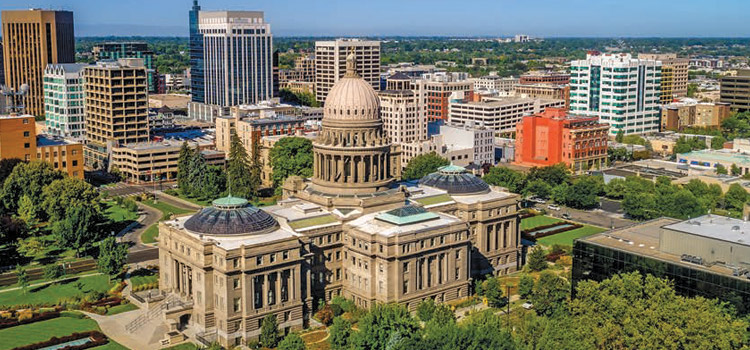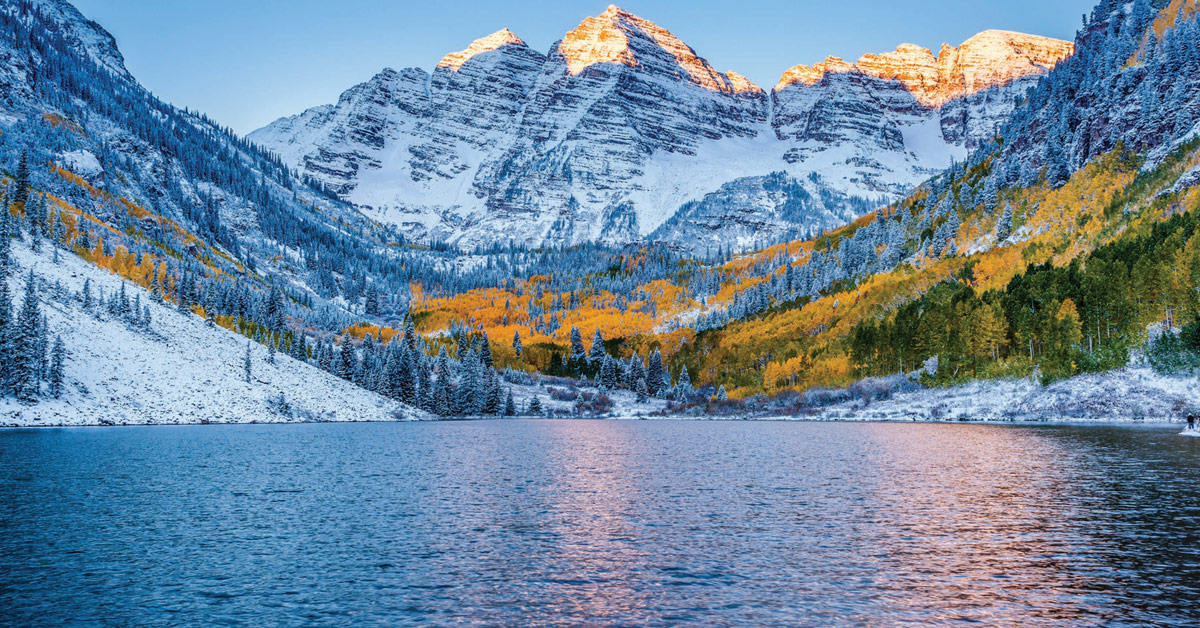Established by an act of Congress in 1978, the Continental Divide Trail runs some 3,100 miles between Mexico and Canada along the spine of the Rocky Mountains. It’s one of the three “Triple Crown” trails in the U.S. for long-distance hikers — the others being the Pacific Crest Trail on the West Coast and the Appalachian Trail on the East Coast.
Annually, several hundred people attempt an end-to-end trek of the Continental Divide Trail. Only about one-third make the entire trip. Those that hike, bike or ride horses over any portion of the trail can observe the natural beauty and rugged terrain that continues to attract people to this part of the country.
 The Continental Divide Trail cuts through the Mountain Region states of Colorado, Idaho, Wyoming and Montana. This is a fast-growing region as Idaho and Colorado ranked in the top 10 of all states for population gains between 2010 and 2020.
The Continental Divide Trail cuts through the Mountain Region states of Colorado, Idaho, Wyoming and Montana. This is a fast-growing region as Idaho and Colorado ranked in the top 10 of all states for population gains between 2010 and 2020.
Idaho ranked No. 2 in the U.S. (behind Utah) with 17.3% growth during the decade, reaching a population of 1.8 million people. Colorado ranked No. 6 with a population growth rate of 14.8% to reach 5.8 million residents. Montana grew to nearly 1.1 million residents thanks to a 10% increase over this time.
While the other Mountain Region states experienced a population boom, Wyoming only added about 18,000 people during these 10 years, a 2.3% growth rate that was the sixth slowest in the U.S. The Equality State now has about 582,000 residents.
Every state in the country suffered an economic blow in 2020 and struggled with the effects of the COVID-19 pandemic. Wyoming was hit especially hard due to the loss of tourism and the collapse of global energy markets. Its gross domestic product (GDP) declined by 7% in 2020, second worst only to Hawaii. The Equality State lost nearly 6,000 jobs in the oil and gas industry, and also shed 10,700 restaurant and hotel workers after national parks closed for a few months.
Other states in the region suffered declines but not nearly as sharply. Montana saw a 3% GDP decline while Colorado and Idaho dropped by 1.5% and 1.1%, respectively.
Colorado’s economy has been bolstered in recent years by growing its advanced-technology industries. The Centennial State ranked No. 2 in the nation as a high-tech hub in a 2020 study from the Milken Institute. The study looked at research and development, capital investments, and technology and science workforces, among other categories. Idaho ranked No. 26, Montana No. 29 and Wyoming No. 39.
Wyoming and Idaho are among the states with the lowest percentage of adults who have been fully vaccinated against COVID-19. Late this past July, Wyoming ranked 47th in the U.S. with only 45.8% of adults fully vaccinated. Idaho ranked 42nd with 49.6% vaccinated. Montana and Colorado were in the middle of the pack for vaccinations with respective rates of 54.1% and 65.1%. ●
 Idaho led the nation in home-price growth over the past year, according to Zillow. The Gem State saw its typical home value increase by nearly $100,000, going from $307,349 in June 2020 to $403,291 in June 2021. That was good for 31.2% year-over-year growth.
Idaho led the nation in home-price growth over the past year, according to Zillow. The Gem State saw its typical home value increase by nearly $100,000, going from $307,349 in June 2020 to $403,291 in June 2021. That was good for 31.2% year-over-year growth.
Montana and Colorado also had rapidly increasing home prices. Montana’s typical home value increased by 18.4%, or more than $50,000, to $359,678. This was the nation’s 10th-fastest home-price growth for the year ending this past June, according to Zillow.
Colorado’s typical home value increased by $70,000 or 16.7% in this time frame to reach $490,944. This was good for 15th in the nation. But Wyoming hasn’t enjoyed the same price gains. The typical home value there increased by 5.2% to $273,992, growth that ranked 48th in the U.S.
Escalating home prices are causing consternation in these states. A regional economist noted that home-price growth is far outstripping wage increases in Idaho. This is leaving frustrated residents worried that they may be priced out of the housing market in Boise and the surrounding Treasure Valley. In Montana, real estate agents are reporting an influx of interested buyers from California. One agent told SFGate.com that 85% of her buyers were from out of state.
Focus: Skiing
The skiing and snowboarding industry generated $55 billion in retail spending for the U.S. economy in 2016 (the most recent data available), including the cost of equipment, travel and services. The industry supports 533,000 jobs. Few areas of the country benefit more from the economic impact of these sports than the Mountain Region.
The area is home to 73 of the nation’s 470 ski resorts, or one in seven of all resorts in the U.S. Colorado features six of the top 10 most-visited ski resorts in the U.S., including Vail Mountain and Breckenridge. These resorts rank first and second, respectively, as each draw more than 1.6 million visitors annually.
Each of the Mountain Region states has popular ski resorts, including Sun Valley Resort in Idaho, Jackson Hole Mountain Resort in Wyoming and Big Sky Resort in Montana. Nationwide, ski resorts sustained an estimated loss of $2 billion in 2020 as the COVID-19 pandemic caused 93% of resorts to end their seasons prior to their scheduled closing dates. Resorts also lost summer business, including conferences, weddings and other events.
What the locals say
“[Colorado is] definitely seeing that buyer exhaustion. The thing that we’re seeing, though, is that we still don’t have enough supply even for the lowered buyer demand. So, instead of a hundred showings, 50 offers and $75,000 over asking (price), what we’ve been seeing the last couple of weeks is more like 10 to 15 showings, three offers, and $5,000 to $25,000 over asking. It definitely continues to be a market in demand, just not as extreme as it was.”

Nicole Rueth
Senior vice president, Fairway Independent Mortgage Corp.
3 Cities to Watch
Boise
 Idaho’s capital has experienced a major boom for the past several years and was the fastest-growing city in the U.S. in 2018. With a metro-area population of 790,000, Boise is beginning to face the challenges of growth. The area’s median home price jumped from $360,000 to $523,000 in the past year. Large employers include Micron Technology with more than 5,000 employees, food processor J.R. Simplot with more than 2,000 employees and HP Inc. with about 1,500 workers. The median household income is $60,035.
Idaho’s capital has experienced a major boom for the past several years and was the fastest-growing city in the U.S. in 2018. With a metro-area population of 790,000, Boise is beginning to face the challenges of growth. The area’s median home price jumped from $360,000 to $523,000 in the past year. Large employers include Micron Technology with more than 5,000 employees, food processor J.R. Simplot with more than 2,000 employees and HP Inc. with about 1,500 workers. The median household income is $60,035.
Bozeman
 An enduring Western mystery is who killed John Bozeman, who led wagon trails to western Montana’s gold mines and settled the town that bears his name. He reportedly was killed by Blackfeet Indians, but rumors persist that it was a business partner or hired henchman. Today, Bozeman (population 50,000)
An enduring Western mystery is who killed John Bozeman, who led wagon trails to western Montana’s gold mines and settled the town that bears his name. He reportedly was killed by Blackfeet Indians, but rumors persist that it was a business partner or hired henchman. Today, Bozeman (population 50,000)
Colorado Springs
 William Jackson Palmer, a Union Civil War general and railroad magnate, founded Colorado Springs 150 years ago with the intent to create a resort community near Pikes Peak and the Garden of the Gods. As Colorado’s second most-populous city (478,000), Colorado Springs is nicknamed “Olympic City USA” due to its U.S. Olympic and Paralympic Training Center. The city has a diverse economic base bolstered by five nearby military installations, including the U.S. Air Force Academy. The median household income is $64,712.
William Jackson Palmer, a Union Civil War general and railroad magnate, founded Colorado Springs 150 years ago with the intent to create a resort community near Pikes Peak and the Garden of the Gods. As Colorado’s second most-populous city (478,000), Colorado Springs is nicknamed “Olympic City USA” due to its U.S. Olympic and Paralympic Training Center. The city has a diverse economic base bolstered by five nearby military installations, including the U.S. Air Force Academy. The median household income is $64,712.
Sources: Boise Valley Economic Partnership; Bozeman Daily Chronicle; Britannica.com; Casper Star-Tribune; City of Colorado Springs; Continental Divide Trail Coalition; Curbed; Hart Real Estate Solutions; KTVB-TV; Milken Institute; National Ski Areas Association; SFGate.com; The New York Times; The Washington Post; Travel + Leisure; U.S. Bureau of Labor Statistics; U.S. Census Bureau; U.S. Department of Commerce; U.S. News & World Report; Visit Colorado Springs; Wyoming Public Radio; Zillow








